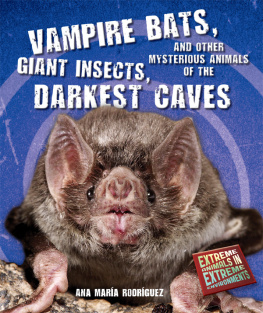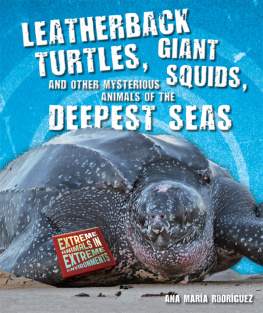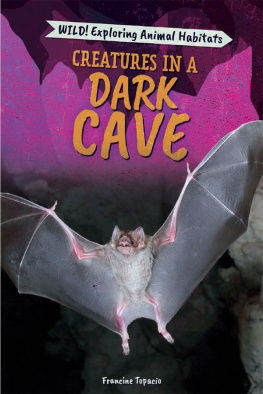EXPLORE THE EXTREME ANIMALS OF THE DARKEST CAVES!
How does a blind fish find food? Can a giant centipede eat a bat for dinner? Caves are home to unique and bizarre creatures. Cave dwelling animals have found amazing ways to survive in complete darkness. Although the food supply is low and the environment can be toxic, many species thrive in the darkest caves. Author Ana Mara Rodrguez explores these remarkable creatures and uncovers how they survive in one of the most extreme environments on Earth.
ABOUT THE AUTHOR
ANA MARA RODRGUEZ was a scientist doing research in immunology and other biological sciences for over twenty years. She is currently a full-time writer with twenty books published.
Stephen discovered underground rivers in Mammoth Cave. He saw eyeless fish swimming in them. No one had heard of such creatures. Scientists came from all over the world to study them
Stephen Bishop: Cave Explorer, by Judith Boogaart

Image Credit: Alan Cressler
This is the entrance to Kentuckys Mammoth Cave, the worlds longest known cave system, with more than 390 miles explored.
Caves are home to bizarre creatures. Take blind fish, for example, like the one Stephen Bishop caught in an underground river in Mammoth Cave, Kentucky. Stephen Bishop was a slave owned by Franklin Gorin, who also owned Mammoth Cave. In the 1830s, Gorin opened the cave to visitors and placed seventeen-year-old Stephen Bishop as the tour guide.
But he was much more than a guide. He was so curious and courageous that he found and explored more underground passages and chambers than any other guide of his time. Many consider him the first American cave explorer. Bishop called Mammoth Cave grand, gloomy, and peculiar, and the cave stands true to its name. According to the U.S. National Park Service, Mammoth Cave has about 390 miles (628 kilometers) of passages explored, which makes it the longest known cave system in the world.
Cave exploration, or spelunking, is popular all over the world. Cave explorers, or cavers, climb up or down, rappel, crawl on mud, dive in dark water, wade, or walk for miles to reach these underground worlds. Caves are extreme environments for animals mainly because they are totally dark and may have very limited food supplies.
Caves are cold and humid. The temperature varies little compared to the temperature outside the cave. In summer, caves are cooler than outside and in winter they provide a warmer environment. About 15 percent of our planets land is shaped by caves and similar land features, such as sinkholes, springs, and blind valleys.
Water carves rocks and forms caves. Caves are mostly in a type of rock called limestone. Limestone is made primarily of a mineral called calcite. Calcite does not dissolve in pure water, but dissolves quickly in acidic water. (Acids taste bitter. Vinegar and lemon juice are examples of mild acids).
Most large caves are solution caves. They form when acidic water seeps through cracks or pores (minute holes) on the surface of the ground. The water is acidic because it contains carbonic acid. Some of the carbonic acid forms in rainwater when it picks up carbon dioxide (CO2) from the atmosphere. The acid dissolves calcite, which enlarges existing fissures or cracks on rocks. Carving a cave by this process may take tens of thousands of years, or even millions of years. Mammoth Cave, the one explored by Stephen Bishop, was formed this way. McDougals Cave, which is described in Mark Twains The Adventures of Tom Sawyer, is a real solution cave located near Twains hometown of Hannibal, Missouri. The actual cave has about two miles of zigzagging passages.

Image Credit: Shutterstock.com
Caves are mostly made up of a type of rock called limestone. This is the inside of a limestone cave in South Africa.
There are places where a stronger acid forms, called sulfuric acid. In this case, microbes living deep inside the ground transform hydrogen sulfide (H2S) into the acid. Because sulfuric acid is stronger than carbonic acid, it carves bigger caves faster. Famous Movile Cave in Romania This type of cave is one of the most extreme environments ever found and home to living creatures not found anywhere else.
- Many caves are formed in landscapes called karst. The word comes from Kras, a region in Slovenia with abundant limestone landscapes carved with deep caves. Karst is a landscape characterized by rock that can be dissolved by weak acids. This process helps the formation of caves and underground streams.
- Caves have few or many chambers connected by intricate passages. Passages can be large enough for people to walk through. Others can be narrow and small, forcing cavers to crawl or drag their bodies. Underground rivers may flow through caves, and lakes flood parts of or whole chambers. Some caves have one or more natural openings. Others have been totally isolated from the surface world for thousands or maybe millions of years until humans found them, usually by accident.
- Cave chambers come in all sizes and shapes. Some have room enough to fit the largest aircraft.
- Some caves are underwater, and cavers need to use diving equipment to reach them. The cenotes (se-NO-tays) of the Yucatn Peninsula are hundreds of water-filled sinkholes surrounded by thick jungle vegetation.
- Besides caves, aquifers form another important subterranean habitat for underground wildlife. Aquifers are layers of rock, sand, or gravel through which enough water flows to supply wells and springs. Some aquatic cave invertebrates and vertebrates live mostly in aquifers.
The sea also carves caves as the waves constantly pound on cliffs. Slowly, over long periods of time, the persistent ocean enlarges openings in rock that become caves. Greenland, which is the worlds largest island, is mostly located at the north of the Arctic Circle. Greenland is covered by permanent huge ice formations called glaciers that have rugged surfaces, deep cracks, and crevasses. During summer, the sun melts the top layers of glacier ice. Water trickles first and, in time, becomes furious rivers that rush over the surface and fall through crevasses that carve caves inside the ice. Even in these hundreds-of-years-old frozen caves, life has found a way.
Lava can form caves called lava tubes. Kilauea volcano in Hawaii created Kazumura (or Kazamura) Cave. It has more than 41 miles (65.5 kilometers) of passages, which makes it the longest lava cave in the world. Lava tubes form much quicker than solution caves. Kazumura Cave is between 350 and 700 years old.
The process of forming lava caves begins with a volcanic eruption churning out thick streams of magma or liquid lava. Rivers of lava slide down the volcano, and the air begins to cool down the outer layer, which then becomes hard. But underneath the hardened surface, lava continues to flow creating a tunnel through which lava flows as long as the volcano spits it out. Once the volcano runs out of lava, the tunnel is empty leaving behind a lava cave.

Image Credit: Alan Cressler














